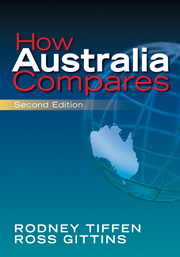Book contents
- Frontmatter
- Contents
- List of tables and figures
- Preface to the second edition
- Acknowledgements
- Reading the tables
- Abbreviations
- Introduction
- 1 People
- 2 Government and politics
- 3 Economics
- 4 Work and labour
- 5 Government taxes and spending
- 6 Health
- 7 Education
- 8 Inequality and social welfare
- 9 International relations
- 10 Environment
- 11 Science and technology
- 12 Telecommunications and computing
- 13 Media
- 14 Family
- 15 Lifestyles and consumption
- 16 Crime and social problems
- 17 The search for scoreboards
- 18 The Howard impact
- Sources and references
1 - People
Published online by Cambridge University Press: 05 June 2012
- Frontmatter
- Contents
- List of tables and figures
- Preface to the second edition
- Acknowledgements
- Reading the tables
- Abbreviations
- Introduction
- 1 People
- 2 Government and politics
- 3 Economics
- 4 Work and labour
- 5 Government taxes and spending
- 6 Health
- 7 Education
- 8 Inequality and social welfare
- 9 International relations
- 10 Environment
- 11 Science and technology
- 12 Telecommunications and computing
- 13 Media
- 14 Family
- 15 Lifestyles and consumption
- 16 Crime and social problems
- 17 The search for scoreboards
- 18 The Howard impact
- Sources and references
Summary
Global population
The pace of population growth is dramatically apparent in Table 1.1. It took tens of thousands of years for the earth's population to reach one billion, while the next billion then took 123 years to add, but the third billion took only 33 years. Between 1987 and 1999, when the earth's population reached six billion, it took only 12 years to add a billion people. According to Nobel Prize-winning economist Robert Fogel, the increase in the world's population between 1900 and 1990 was four times as great as the increase during the whole previous history of mankind.
This population explosion is testimony to mankind's success. It was the mastery of agriculture, the ability to live in cities, and the ability to reduce disease and other threats to longevity that made the increase possible. However, the success threatens to bring its own problems. In particular, six billion people – especially experiencing a much higher standard of living – have a far greater impact on the earth's environment. If current trends in population growth are projected forward, they could threaten the planetary carrying capacity.
However, projecting forward is problematic. The United Nations Population Division, from whose data the table is drawn, sees the current rate of growth continuing in the near future, but thinks it will slow considerably by the middle of the 21st century, and from then on.
- Type
- Chapter
- Information
- How Australia Compares , pp. 4 - 23Publisher: Cambridge University PressPrint publication year: 2009



